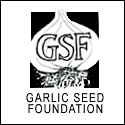
GARLIC SKINS FROM YESTERDAY'S MARATHON PLANTING SESSION
As promised, here are the descriptions of the different garlic varieties I planted. Descriptions of different types of garlic is below.
Moldovan Purple: I was over the moon when Colin Boswell, who runs The Garlic Farm on the Isle of Wight gave me two heads of his prized Moldovan Purple garlic. My father’s family fled Moldova at the turn of the 20th century and it’s been an obsession of mine for as long as I can remember. Shortly before my first, long-awaited visit to my ancestral homeland last month, I was chagrined to learn that Moldovan Purple is actually native to Kazakhstan. In The Garlic Farm cookbook, Moldovan Purple is defined as “a warm garlic with real persistence and amazing aroma that makes the best garlic bread.”
Solent Wight: Named after the Solent, the estuary that separates the Isle of Wight from the mainland. This is another treat from The Garlic Farm that I smuggled from the UK to the US. “Large, hard, dense white bulbs with an elegant bouquet.”
Persian Star: This hard neck purple stripe was obtained by amateur garlic aficionado (and professional lawyer) John Swenson. Swenson was invited to join the 1989 garlic collection mission across the former Soviet Union by virtue of his passion and knowledge. Although Swenson picked up this variety in Uzbekistan, garlic grower Horace Shaw thought it sounded “Persian” and gave it its name. My bulbs came from PD Farm in Elgin, Oregon.
Ukrainian Red: This spicy garlic has “an initial bite that dissipates quickly leaving a nice buttery finish” making it sound like a cross between an angry dog and a California chardonnay. Purchased from Rutkowski Farm in Ballston Spa, New York at the Hudson Valley Garlic Festival.
Georgian Fire: This white hot porcelain garlic from the Republic of Georgia, was one of many rescued from obscurity from the Gatersleben Gene Bank, located in the former East Germany. My personal favorite, this year's batch came from Maplewood Gardens in Elderon, Wisconsin. CORRECTION: Maplewood Gardens couldn't send out garlic because of adverse weather conditions. My Georgian Fire came from A One of a Kind Farm in Selma, Oregon.
Hungarian Purple Stripe: I purchased this Rocambole from Witchcat Farm in Bakersfield, Vermont at the Hudson Valley Garlic Festival. In addition to growing awesome garlic in the “Northern Kingdom,” Witchcat Farm supplies garlic to the Bread & Puppet Theater which serves bread with aioli (garlic mayonnaise) after most of its performances.
Bavarian Purple: A porcelain garlic with a mellow, mild flavor from Bob Anderson’s Gourmet Garlic Gardens (henceforth GGG).
Amish: A Rocambole garlic with very rich garlic flavor that’s very hot when raw. Also from GGG.
Music: This porcelain garlic is named for Canadian garlic grower Al Music, is one of the most popular among home growers. Large, easy-to-grow bulbs (or so I’m told). Also from GGG.
Purple Italian Rocambole: Another rich flavored bulb that’s hot when raw from GGG. Along with Reisig, the plumpest bulbs I planted.
Korean Red: A hardneck with great hot flavor from Ireland Farm in Fulton NY (purchased at the HV festival.)
Russian Red: A Rocambole with strong flavor with a sweet aftertaste that was brought into the American Northwest by Russian Doukhobor immigrants in the early 1900s. Purchased from The Garlic Guy at the HV festival.
Spanish Roja: An heirloom Rocambole introduced to Portland Oregon over a hundred years ago. Also from The Garlic Guy at the HV festival.
Turkish Red: “Our strongest garlic” was all the folks at Piedmonte Garlic Farm had to say and I was in. (I also bought a large bag of Piedmonte’s Russian Renegade -- “their second strongest garlic,” but for some reason, the bulbs went bad before I could plant the “ugly but hot” cloves.
Riesig: This hot, large garlic (that’s all I know about it) hails from Cedarville Farm and tied with Italian Purple for fattest cloves.
I think it was a rough growing season all around and I didn’t get some of my favorites: Red Toch, Pskem, Metechi, and Bogatyr. Although that could also be because I begged Bob Anderson for Rose de Lautrec (a delicate pink garlic from the south of France) and Cuban Purple (a Creole from Spain that was originally called Castro Purple until, I assume, the marketing folks figured out that naming something after a dictator wasn’t suited to these politically-charged times.) Both are probably too delicate to survive the northeast winter so I’m thinking of trying to grow them in containers.
Garlic comes in hard neck and soft neck varieties. Ron Engeland, author of Growing Great Garlic, has broken garlics into seven main types. (The following descriptions are from Filaree Farms though any mistakes in transition are mine.) Hard necks are traditionally more full-bodied than soft necks. Hard neck varieties are Rocambole (the most widely grown -- popular because they produce large, flavorful easy-to-peel cloves), Purple Stripe (very flavorful and pretty), Porcelain (more flavorful than Rocamboles but harder to find; they also produce lower yields), Asiatic/Turban (an Artichoke variety that morphed from soft neck to hard), and Creole (the most delicate of the hard necks and best grown in southern climates). Sort necks, the braidable variety, includes Artichoke (large, vigorous bulbs) and Silverskins, the most popular for supermarkets because of their large storage life).
Labels: Bread and Puppet, GARLIC, Gourmet Garlic Gardens, Rocambole



























